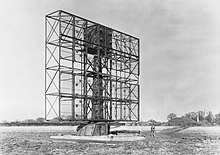 Type 7 radar antenna at RAF Sopley in 1945. The happidrome visible in the background. | |
| Country of origin | UK |
|---|---|
| Manufacturer | Marconi |
| Introduced | 1941 |
| No. built | ~33 |
| Type | Ground-controlled interception |
| Frequency | 209 MHz (1.5 m, VHF), later 193 and 200 MHz |
| PRF | 250 to 540 pps |
| Beamwidth | 15° |
| Pulsewidth | 3.6, 5 or 8 μs |
| RPM | 0.5 to 8 rpm |
| Range | 220 nmi (410 km) theoretical, ~90 mi (140 km) in practice |
| Altitude | 80,000 ft (24,000 m) |
| Diameter | 30 by 25 ft (9.1 by 7.6 m) |
| Azimuth | 360º |
| Elevation | 2.5 to 20º |
| Precision | ~1.5° in azimuth, 500 m in elevation |
| Power | 80-100 kW |
| Other Names | Final GCI, happidrome, SCR-527 |
| Related | AMES Type 8, AMES Type 15 |
The AMES Type 7, also known as the Final GCI, was a ground-based radar system introduced during World War II by the Royal Air Force (RAF). The Type 7 was the first truly modern radar used by the Allies, providing a 360 degree view of the airspace around the station out to a distance of about 90 miles (140 km). It allowed fighter interceptions to be plotted directly from the radar display, a concept known as ground controlled intercept, or GCI.[a]
Earlier radars, like Chain Home (CH), provided the range and angle to a single target at a time. Arranging an intercept required a complex series of reports from multiple stations that were plotted at a central station. In a seminal 1939 memo, Robert Hanbury Brown showed that this Dowding system resulted in an inherent inaccuracy of approximately 5 miles (8.0 km), and the only way to reduce this would be to arrange the interception directly from the radar screen. He suggested spinning the radar antenna and the CRT display to produce a 360 degree picture of the airspace around the station, a concept he referred to as a plan position indicator, or PPI.
To test the concept, the AMES Type 8 was developed from the existing GL Mk. II radar, with a new antenna that was manually rotated to scan the area around the station. When the Type 8 was first used in December 1940 it proved extremely effective. Lessons learned on the Type 8 led to the production Type 7 design,[b] which began deployment at the end of 1941. Starting in 1942, the installations began to be upgraded to permanent buildings known as "happidromes". From that point, the RAF's interest in the system waxed and waned along with the German bombing efforts and full deployment was repeatedly delayed. The stations began to take over most interception duties in 1943, but it was not until 1944 that the full network of 33 stations was completed. An American copy, the SCR-527, was not produced in quantity.
Late in the war, many UK radars were no longer staffed as the risk of German attack disappeared, and most were put into "care and maintenance" when the war ended. The detonation of the first Soviet atomic bomb in 1949 led to a re-evaluation of post-war alert status. As part of the ROTOR project, many Type 7's were re-activated, upgraded, and re-built in bomb-proof buildings. Most Type 7's were later displaced by the much more capable AMES Type 80, but a small number were kept to fill gaps in the Type 80's coverage, while others were kept as backup systems. Type 7's remained in backup service until the Linesman/Mediator program of the 1960s.
Cite error: There are <ref group=lower-alpha> tags or {{efn}} templates on this page, but the references will not show without a {{reflist|group=lower-alpha}} template or {{notelist}} template (see the help page).
© MMXXIII Rich X Search. We shall prevail. All rights reserved. Rich X Search
